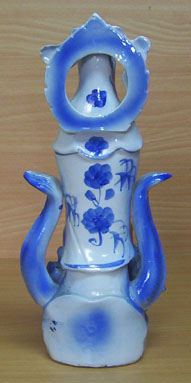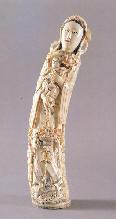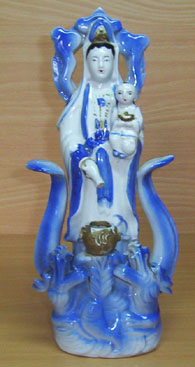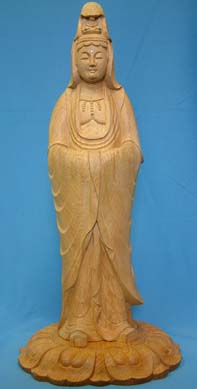Mercy, Representation in Asian Religions
Mercy and Mary in Asian Religions
– Father Johann Roten, S.M.
Mother of Mercy
The "Mother of Mercy" of Asia is a fascinating figure with various names and spellings, and a rich number of visual representations and symbolic meanings.
VARIOUS REPRESENTATIONS
The Vatican Museum:
Anonymous (China, Ming Dynasty)
Madonna and Child
ivory
Missionary-Ethnological Museum, Inv. AS 10059
Most likely by a Chinese artist, this work bears the inscription Da Ming Nian Zhi, meaning, “executed at the time of the great Ming” (1368-1644) which would theoretically allow for a datation anywhere between 1549 (Francis Xavier attempts to enter China) and 1644. More realistically, the date of origin should be fixed at a time between 1600 and 1620. This piece is unique not only because of its physical appearance, but also for its theological message of inculturation. It is carved from an elephant tusk, and features in limited space Mother and Child, the "horn of plenty" (cornucopia), two angels, and a dragon, not to mention the many decorative accessories. As an example of the latter, see the lotus flowers adorning Mary’s dress, symbolizing longevity and purity. The delicate chromaticism and finely carved features, as well as the harmonious integration of the sculptural form with the physical reality of the tusk, are indicative of high quality art and exquisite craftsmanship. The sculpture was a gift to Pope Paul VI, and until 1973 embellished the Pontifical Antechamber.
The Korean Marian Library:

Brother Vianney Ahn, director of the Korean Marian Library, recently discovered a porcelain representation of Gwan-Um while dining in a Chinese restaurant. He was able to buy the statue at a modest price. The blue and white colored artwork is one of the prized possessions of the Marian Library in Seoul. The feminine figure is holding the baby and stands on two dragons.
The Dayton Marian Library:
This wooden sculpture by Fr. Luke Asayama, is a skillful rendering of the Gwan - Um sculpture.
Standing in White Clothing at Deidon University, Japan. The dimunitive form of a child under her veil identifies Gwan - Um as the "bestower of children."
VARIOUS MOTIFS
In many images she is depicted carrying the pearls of illumination. Often Quan Yin is shown pouring a stream of healing water, the "Water of Life," from a small vase (see sculpture of Korean Marian Library). With this water devotees and all living things are blessed with physical and spiritual peace. She holds a sheaf of ripe rice or a bowl of rice seed as a metaphor for fertility and sustenance. The dragon, an ancient symbol for high spirituality, wisdom, strength, and divine powers of transformation, is a common motif found in combination with the Incarnation of Mercy. Guam-Um standing on the dragon may also have the meaning of mercy and compassion superseding powers.
Scholars believe that the Buddhist monk and translator Kumarajiva was the first to refer to the female form of Kuan Yin in his Chinese translation of the Lotus Sutra in 406 A.D. Of the thirty-three appearances of the bodhisattva referred to in his translation, seven are female. (Devoted Chinese and Japanese Buddhists have since come to associate the number thirty-three with Kuan Yin).
The iconography of Kuan Yin depicts her in many forms, each one revealing a unique aspect of her merciful presence. As the sublime Goddess of Mercy whose beauty, grace and compassion have come to represent the ideal of womanhood in the East, she is frequently portrayed as a slender woman in flowing white robes who carries in her left hand a white lotus, symbol of purity. Ornaments may adorn her form, symbolizing her attainment as a bodhisattva, or she may be pictured without them as a sign of her great virtue.
Kuan Yin's presence is widespread through her images as the "bestower of children" which are found in homes and temples. A great white veil covers her entire form and she may be seated on a lotus. She is often portrayed with a child in her arms, near her feet, or on her knees, or with several children about her. In this role, she is also referred to as the "white - robed honored one." Sometimes to her right and left are her two attendants, Shan - tsiai Tung tsi, the "young man of excellent capacities," and Lung - wang Nu, the "daughter of the Dragon-king."
Kuan Yin is also known as patron bodhisattva of P'u - t'o Shan, mistress of the Southern Sea and patroness of fishermen. As such she is shown crossing the sea seated or standing on a lotus or with her feet on the head of a dragon.
Symbols characteristically associated with Kuan Yin are a willow branch, with which she sprinkles the divine nectar of life; a precious vase symbolizing the nectar of compassion and wisdom, the hallmarks of a bodhisattva; a dove, representing fecundity; a book or scroll of prayers which she holds in her hand, representing the dharma (teaching) of the Buddha or the sutra (Buddhist text) which Miao Shan is said to have constantly recited; and a rosary adorning her neck with which she calls upon the Buddha's for succor.
Images of Avalokitesvara often show him holding a rosary; descriptions of his birth say he was born with a white crystal rosary in his right hand and a white lotus in his left. It is taught that the beads represent all living beings and the turning of the beads symbolizes that Avalokitesvara is leading them out of their state of misery and repeated rounds of rebirth into nirvana.
Today, Kuan Yin is worshipped by Taoists as well as Mahayana Buddhists - especially in Taiwan, Japan, Korea and once again in her homeland of China, where the practice of Buddhism had been suppressed by the Communists during the Cultural Revolution (1966-69). She is the protectress of women, sailors, merchants, craftsmen, and those under criminal prosecution, and is invoked particularly by those desiring progeny. Beloved as a mother figure and divine mediatrix who is very close to the daily affairs of her devotees, Kuan Yin's role as Buddhist Madonna has been compared to that of Mary, the mother of Jesus in the West.
THE MOTHER OF MERCY
To enter into fruitful religious dialogue with Buddhism, experts in Asian theology advise to highlight mercy and passion. These two themes are representative of Buddhist doctrine. Avalokitesvara, or Buddha, has suffered ascetically in order to free people from the pains of earthly existence. This sculpture goes one step further. It blends into one: Mary, mother of Mercy, and Guanyn or Gwan - Um. In China and Korea, Avalokitesvara was represented in feminine form, and is venerated as a gentle and compassionate “Madonna” called Guanyn (China) and Gwan - Um (Korea). She is described as a model of mercy and may be compared to Mary, Mother of Mercy. Like Mary, she dedicates her personal mission to mercy, as mother of everyone. Sculpting his Madonna and Child, the artist was inspired by Guanyn. She is frequently depicted with a child in her arms, riding a dragon. Placed in front of waterfalls or on rocks, she leads stranded sailors to safety. The artist added two little angels to give the sculpture a more pronounced Christian character.
There are, of course, differences between Guanyn and Mary. Guanyn is not a historical person. Legend describes her as a princess, Miao Shan. As idealized woman, she personifies the Buddha in Mahayana Buddhism, but she is not a goddess, just as Mary should not be mistaken with a feminine face of God. Guanyn is the bodhisattva Avalokitesvara among many other bodhisattvas. Her mission is mercy and she leads to Nirvana. Mary’s mercy leads to the Cross, the source and reason of God’s mercy.
All About Mary includes a variety of content, much of which reflects the expertise, interpretations and opinions of the individual authors and not necessarily of the Marian Library or the University of Dayton. Please share feedback or suggestions with marianlibrary@udayton.edu.



